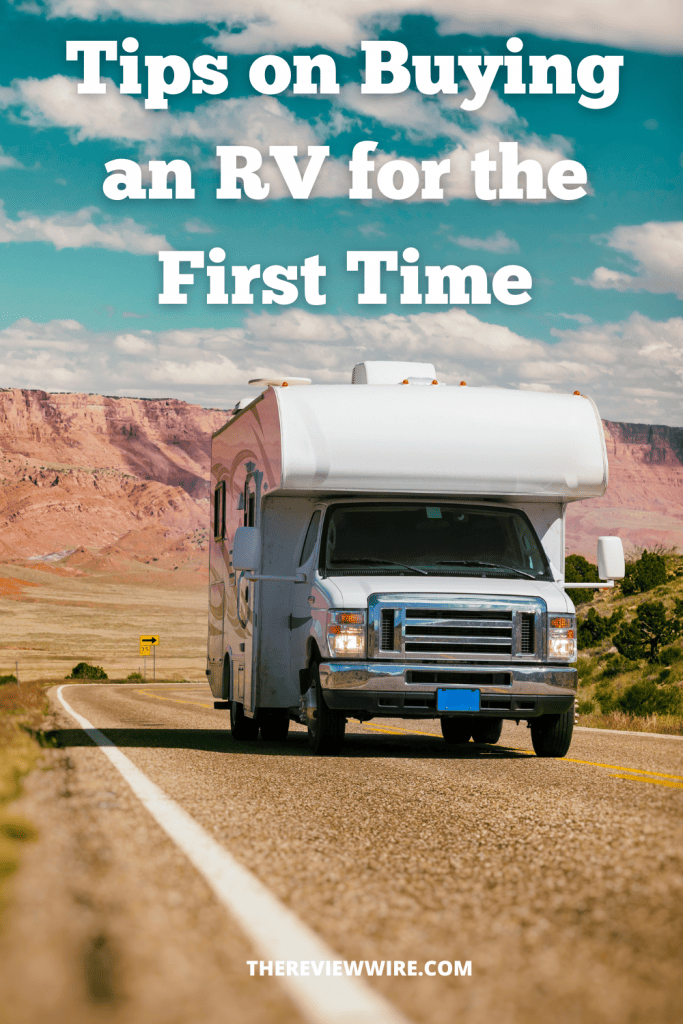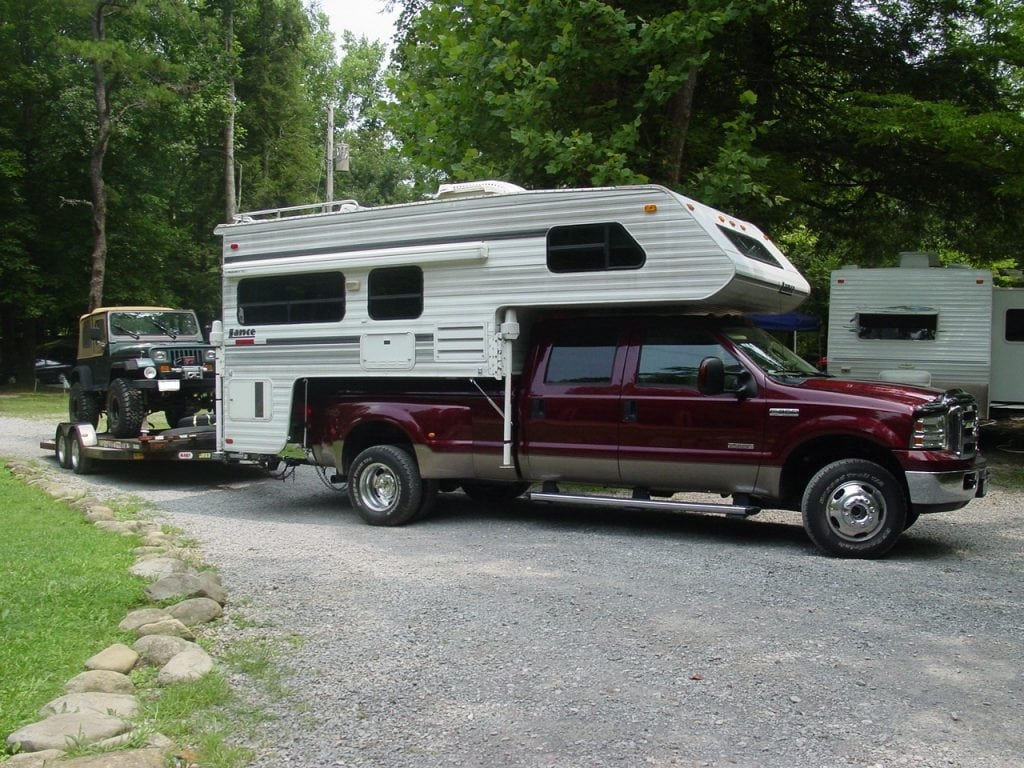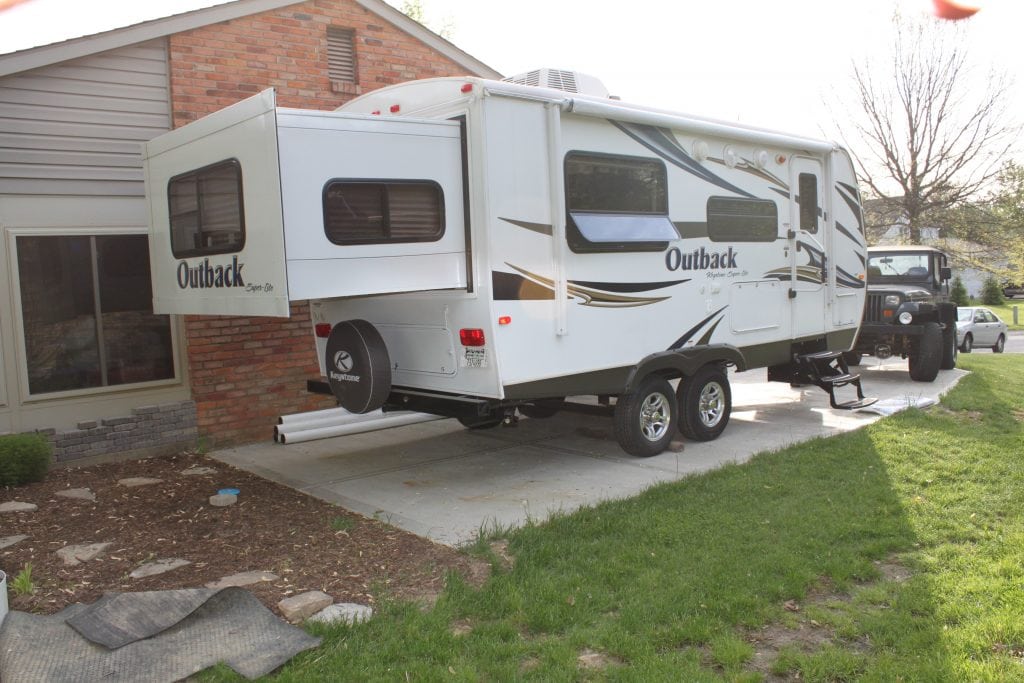This post may contain affiliate links. The Review Wire may collect a share of sales if you decide to shop from them. Please see my full disclosure policy for details.
Camping seems all the rage in 2022! RV’s sales soared! In 2017 the total amount of RVs sold was 504,599, and by year-end in 2021, they sold a staggering 600,240. Buying an RV for the first time can be tricky because there are many different kinds to choose from. Not only do you need the trailer (which is what you call the RV that is pulled behind your camper), you need a truck to haul it. It is not a cheap hobby! Many people become overwhelmed because it is such a significant investment.

I have had three RVs in my life. Each one is bigger than the one before. Here is a list of some ideas for buying an RV for the first time.
My first camper was a 1996 Lance truck camper. For this, we had to have a duly. (A duly is a truck with four wheels in the back to hold the camper’s weight.) It was the perfect size for my husband and me at the time. Easy to travel with too. It was nice because you could take the truck camper off the back of the truck, so when you get to your destination, you are not carting the extra weight around. It had all the items you needed, a bed, stove, a bench table for eating, your drawers for dishes, etc.., and a closet and bathroom. It even had a shower, but we did not use that. It was made into a closet for extra space. I was always scared because one thing a camper does not like is water! Most of the campers are made of pressboard, and water warps it. The only way to fix something like that is to pull it out and start over! The Lance was a great size for two people, but we started to get tight once we had my son. We did not purchase a new one until my daughter was born.

1996 Lance Truck Camper
My second trailer was a 2012 Keystone Outback 210RS. This, of course, fit four of us well. One thing I did like about this camper was the length. Something to think about when buying a new camper: it was only 23 feet long when traveling and 28 feet long when you pulled out the bed so that we could fit in a ton more spaces than most RV campers. I liked that we could pull that in almost any camping spot because it is “short.” And yes, 28 feet is VERY short for an RV. The camper had a queen pull-out bed, two bunk beds when you walked in, a bench seat for eating, and a couch across from it. It also had a kitchen area and a bathroom with a shower. I loved the steps that would pull down to get up in the camper because when we stopped at the gas station to fill up, we did not go into the gas station restroom; we would pop the steps down and go into our camper. (No more gross bathroom stops.) The couch would make into a bed, and so would the bench table. Those are standard items that come in a camper, but the bench table sleeping area was short. If you were 5’3, it would be ok, but anyone taller than that would have to curl up. So if you are purchasing a new one, lay down your tallest person to ensure it works. The couch bed was very uncomfortable. The top of the couch pillows was fluffy and great for watching tv, but when you made it into a bed, it left a lump on the side of the bed, so if you were laying, you had to lay on the ‘right’ side of the ‘left’ side. There was no “middle”! I loved the bathroom. It was relatively large, and I used the shower as a closet for all my wet items, bathing suits, wet towels, and a towel shelf system that held all the towels we used for showers. Why did I take showers at the campground instead of my camper? Because water scares me! I have seen way too many campers with water problems! Let me explain that a tad more.
One slip-up in an RV could be a disaster. When you shower, you need a curtain, so the water runs back down into the drain. If that curtain is kicked out for 5 min when you are taking a shower, the water on the floor will absorb into the floor. The floor is laminated and hopefully sealed, but if the water touches any part of the partial board under the laminated floor, your floor will warp. The only solution is to remove the floor and put another board down. That is why I took advantage of the space and used mine as a “closet” to store my bathroom towels and things I would take to the shower house. It worked out well.
Another thing to look for in a trailer is how much storage space you have. Being an avid camper with my parents when I was small, I know how valuable space is. Most campers come with space under the bench seats, at least one closet, and a few cabinets. When looking for one, make sure you think of all the items you will be packing: space for clothes, canned goods, and food, dirty clothes, towels for the beach and showering, and a place for your shoes (yes, because eventually you will have gym shoes, flip flops, and also hiking shoes for each person). You will need drawers for silverware, pots and pans, cups, bowls, and plates. These things can add up, and it is a bummer if you constantly move things around while camping! One of my pet peeves with my second camper was the dirty clothes. I did not have any place for them. They usually ended up on my couch, so each day, they would have to be moved when trying to relax. That sounds easy enough, no. It was not because remember your dirty clothes are smelly and gross so where do you put them? On your bed? On the bench seats where you eat breakfast? By your pots and pans? These are hard questions! We ended up getting a large tub and placing it in the truck. That is where we kept them, in a water-sealed tub in the back of the truck. It worked out great because we also did not have to worry about ticks crawling off the clothes and being lost on the couch for us to find later!

2012 Keystone Outback 210RS
The third and last camper was a 2018 Grand Design Imagine. Because I was putting $30,000 into this camper, it had to be perfect. In the second camper, the kids would have problems getting into the top bunk because they were 5’8 and could not bend over while climbing up the ladder. It was tough to do because of their height. Our new camper came with lots more head space for that top bunk. The next item my new camper had to have was headspace when in the shower. Many of the RVs I looked at would not fit my husband, who is 6′. Once he would get in the shower, he would have his head right by the ceiling, but now when you use the shower head, you are squirting water on the shower ceiling. Remember, RV’s do not like water! That would be an expensive item to fix! I also wanted to ensure my camper had plug-ins for the kids’ phones. I know you are not supposed to have them when camping, but I let them have them in the morning while lying in bed. It makes it easy since they can plug them right by their beds and give them some responsibility.

2018 Grand Design Imagine
Some other tips to look at before purchasing an RV are listed below:
Storage is Important. Since we were getting a bigger camper, I knew we would take friends for the kids. A large area across from the slide-out holds the kids’ clothes. I have split it into four shelves so the kids and their friends get a section. Each has a special Tupperware box that holds their underwear and socks. It makes it easy to reach! Storage was also important when it came to food. I have two cabinets, and the way they are set up, I use one for snacks and one for dinner/lunch food.
Outdoor Kitchen – One crucial quality of that kitchen was the awning that covered the cooking area (you don’t always get to plan for the weather).
Blocks to Balance the Camper – Yes, they make blocks that look like Legos (only really big and durable), so you can level your camper. You may be backing up on 2-4 blocks, so your camper is level. Most campsites are not level.
Floor Inspection – You are looking for mold, warping, or bug damage. These things can cost you a lot of money to repair.
Tires – We always had great tires, but the spare was a different brand! Check the tires to be sure they are all the exact tires, all 5, yes, the spare too!
Walk the Roof – Make sure the roof seals are really sealed. Remember, any hole can take in water; water is not an RV’s friend!
Must-Have Rear Bumper – A bumper means you can travel with bikes. Also, the hose that dumps your blackwater (stool and urine) fits inside; otherwise, you must have a separate container.
RV camping is all the rage; look for my next post in the fall about how to winterize your new purchase to prevent long-term, expensive problems!

I’m curious about the insurance and maintenance costs for an RV or pull behind trailer. After the initial outlay to purchase the RV or a truck and pull behind camper, I’m wondering how much the maintenance and insurance costs would be. It does look like it would be fun to own one, but expensive.
Your tips are very helpful. You also may want to consider a trailer hitch on the back to haul another vehicle.
Great tips! Thank you!
How I would love to have a nice camper, RV, trailer! So many places to go and things to see, without needing hotels.